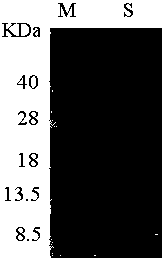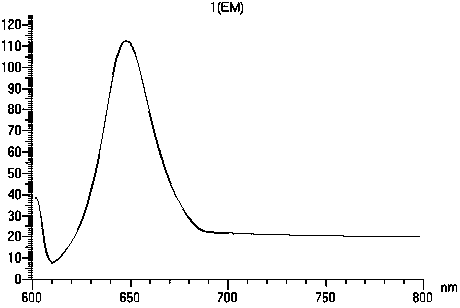Targeting recombinant protein photosensitizer and preparation method thereof
A technology of recombinant protein and photosensitizer, which is applied in the field of preparation of recombinant protein photosensitizer, can solve the problems of low yield, increased toxic and side effects, and high cost, and achieve high yield, improved application effect, and low cost
- Summary
- Abstract
- Description
- Claims
- Application Information
AI Technical Summary
Problems solved by technology
Method used
Image
Examples
Embodiment 1
[0032] (1) Construction of recombinant strains: design primers EGFRi1 and EGFRi2 (SEQ ID 3 and SEQ ID NO: 4), linker1 and linker2 (SEQ ID NO: 5 and SEQ ID NO: 6), and APCα1 and APCα2 (SEQ ID NO: 7 and SEQ ID NO: 8); The total DNA was extracted from algae PCC7120, and the allophycocyanin α subunit gene APCα was cloned by PCR; the EGFRi-linker1 nucleotide sequence was obtained by overlapping extension PCR amplification with EGFRi1 and EGFRi2 as primers; the linker1 and linker2 were used as primers Perform overlap extension PCR amplification to obtain the nucleotide sequence of linker2-APCα1; use EGFRi-linker1 and linker2-APCα1 as templates, and use EGFRi1 and linker2 as primers to perform PCR amplification to obtain the nucleotide sequence of EGFRi-linker-APCα1; EGFRi-linker-APCα1 and APCα were used as templates, and EGFRi1 and APCα2 were used as primers to obtain the complete fusion protein gene sequence; the fusion gene sequence was cloned into the expression vector pCDF- cpc...
Embodiment 2
[0037] (1) Construction of recombinant strains: design primers EGFRi1 and EGFRi2 (SEQ ID 3 and SEQ ID NO: 4), linker1 and linker2 (SEQ ID NO: 5 and SEQ ID NO: 6), and APCα1 and APCα2 (SEQ ID NO: 7 and SEQ ID NO: 8); The total DNA was extracted from algae PCC7120, and the allophycocyanin α subunit gene APCα was cloned by PCR; the EGFRi-linker1 nucleotide sequence was obtained by overlapping extension PCR amplification with EGFRi1 and EGFRi2 as primers; the linker1 and linker2 were used as primers Perform overlap extension PCR amplification to obtain the nucleotide sequence of linker2-APCα1; use EGFRi-linker1 and linker2-APCα1 as templates, and use EGFRi1 and linker2 as primers to perform PCR amplification to obtain the nucleotide sequence of EGFRi-linker-APCα1; EGFRi-linker-APCα1 and APCα were used as templates, and EGFRi1 and APCα2 were used as primers to obtain the complete fusion protein gene sequence; the fusion gene sequence was cloned into the expression vector pCDF- cpc...
Embodiment 3
[0042] (1) Construction of recombinant strains: design primers EGFRi1 and EGFRi2 (SEQ ID 3 and SEQ ID NO: 4), linker1 and linker2 (SEQ ID NO: 5 and SEQ ID NO: 6), and APCα1 and APCα2 (SEQ ID NO: 7 and SEQ ID NO: 8); The total DNA was extracted from algae PCC7120, and the allophycocyanin α subunit gene APCα was cloned by PCR; the EGFRi-linker1 nucleotide sequence was obtained by overlapping extension PCR amplification with EGFRi1 and EGFRi2 as primers; the linker1 and linker2 were used as primers Perform overlap extension PCR amplification to obtain the nucleotide sequence of linker2-APCα1; use EGFRi-linker1 and linker2-APCα1 as templates, and use EGFRi1 and linker2 as primers to perform PCR amplification to obtain the nucleotide sequence of EGFRi-linker-APCα1; EGFRi-linker-APCα1 and APCα were used as templates, and EGFRi1 and APCα2 were used as primers to obtain the complete fusion protein gene sequence; the fusion gene sequence was cloned into the expression vector pCDF- cpc...
PUM
 Login to View More
Login to View More Abstract
Description
Claims
Application Information
 Login to View More
Login to View More - R&D
- Intellectual Property
- Life Sciences
- Materials
- Tech Scout
- Unparalleled Data Quality
- Higher Quality Content
- 60% Fewer Hallucinations
Browse by: Latest US Patents, China's latest patents, Technical Efficacy Thesaurus, Application Domain, Technology Topic, Popular Technical Reports.
© 2025 PatSnap. All rights reserved.Legal|Privacy policy|Modern Slavery Act Transparency Statement|Sitemap|About US| Contact US: help@patsnap.com



